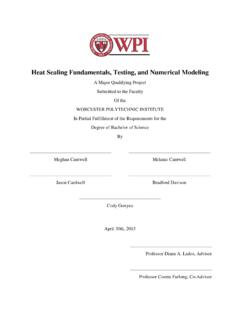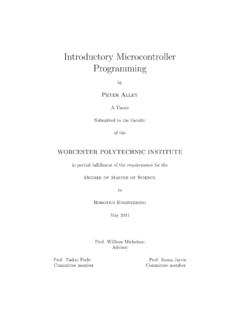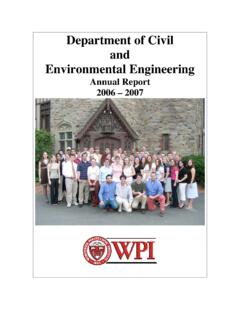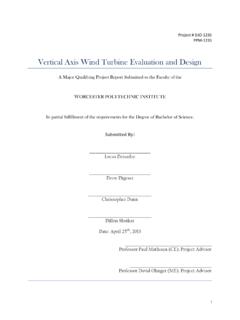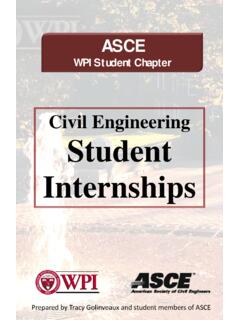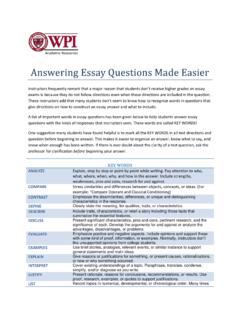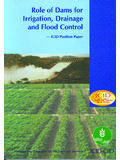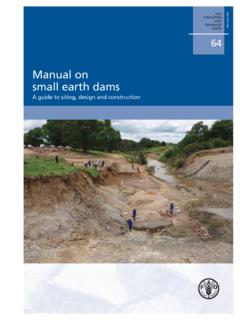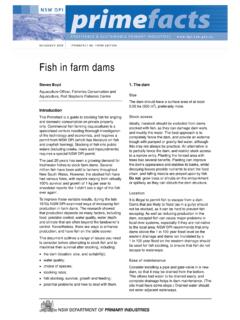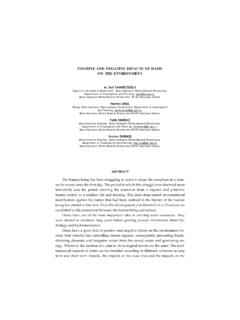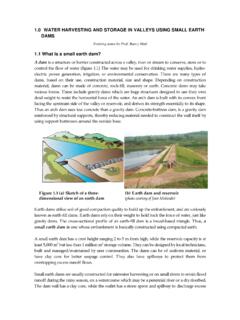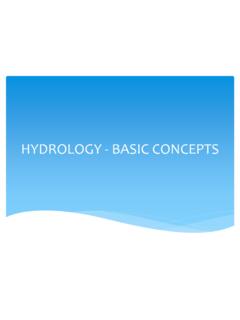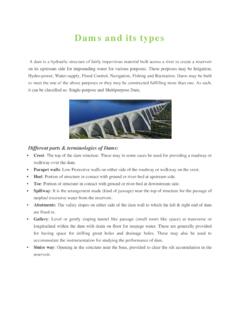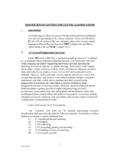Transcription of Grand Ethiopian Renaissance Dam (GERD)
1 IQP-GFS-1504 Grand Ethiopian Renaissance Dam (GERD) An Interactive Qualifying Project Report Submitted to the Faculty of WORCESTER POLYTECHNIC INSTITUTE In partial fulfillment of the requirements for the Degree of Bachelor of Civil Engineering By: _____ Rania A. Attalla October 15, 2015 APPROVED: _____ Prof. Salazar F. Guillermo, Project Advisor i Abstract The development of Great Ethiopian Renaissance Dam (GERD) is causing political escalation of tensions between Ethiopia and Egypt based on current issues and the expectations for requirements that must be met before the completion of the dam construction. These include: engineering design, funding, political agreement, and thorough consideration of all possible options. This study reviews existing alternative solutions and proposes a methodology to assess their relative merits.
2 It also provides suggestions for the efficient use of the water efficiency through reductions in physical losses, re-utilization of drainage and municipal water, and less waste in irrigation . ii Acknowledgements I would like to thank Professor Salazar F. Guillermo of the Civil and Environmental Engineering Department for his contribution and as well his guidance during the course of the project. iii Executive Summary Background: The Nile River is the source of lifeline to about 300 million residents of Africans in 11 different countries. Over the years, there have been many dams built over the river of varying size and capability. These dams were small enough not to cause political upheaval. The construction of the Greater Ethiopian Renaissance Dam (GERD) is causing substantial changes to the water utilization of the river that would significantly impact water supply to Egypt.
3 The GERD is currently in the midst of a large-scale political battle between Ethiopia, Sudan, and Egypt. If the construction of the dam is completed, Egypt may have to find new ways to support the water security for the Egyptian people. Egypt is considered one of the biggest countries in the world suffering from the water supplies, because of its natural conditions, Egypt s total geographic area million kilometer square about 90% of Egypt area is desert and10% is of the area is inhabited and agricultural. Egypt s main source of fresh water is the River Nile which provides about 96% of fresh water supplies; the other sources of fresh water are the aquifers. Egypt has high population of around 95 million people and there is growing demands of fresh water every day (Abdin and Gaafar, 2008).
4 Objective and Scopes: The purpose of this project is to outline the current situation surrounding the construction of the GERD. This project describes requirements that must be met before the completion of the dam construction among these strong engineering design, sufficient funding, political agreement, and thorough consideration of all possible options. The report also describes the political atmosphere that surrounds the issue from the influences of the British Colonial Rule to the current situation among the three basin nations on the Nile River. This study reviews existing alternative solutions and proposes a methodology to assess their relative merits. It also provides suggestions for efficient use of the water efficiency through reductions in physical losses, re-utilization of drainage and municipal water, and less waste in irrigation .
5 Results and Recommendations: Egypt needs a revolution to conserve and manage the fresh water supplies in the face of the growing demands from the population growth, irrigation agriculture, and growth of industries and cities. Solving the water problem will require coordinated response to the problem from local, national and international levels. There are several ways to solve the problem. 1. Water Saving Techniques: There are number of measures can be used towards the rational use of water for different activities. Some of these measures could be applied to domestic water systems and industrial requirement. However, agriculture being the major consumer of water has the largest share of these measures. Following water saving techniques are some of measures applied to agriculture (Abdin and Gaafar, 2008): A.
6 Use of modern irrigation systems in newly cultivated land (Sprinkler and drip irrigation systems must be used in the desert lands) B. Change from surface irrigation to drip irrigation in the orchards and vegetable farms in the old lands. iv C. Land leveling to decrease the amount of water needed to irrigate higher land D. Night irrigation reduces evaporation losses E. Modification of the cropping pattern F. Introduction of short-age varieties the reduction in the number of days is immediately reelected on the number of irrigation gifts and consequently on the quantity of water supplied. G. irrigation improvement projects in the old land H. The change from the earth field ditches named Misqas into canals or pipelines. 2. Optimum Use of Resources A. Reuse of drainage water and treated wastewater B.
7 Desalination of sea water C. Importance of international co-operation between the River Nile basins D. Nile Basin Initiative (NBI) projects water policy good practice guides and support, project planning and management good practice guides, Nile Basin decision support system, and regional coordination and facilitation. E. ENSAP relevant projects can be described as follows: The project may offer opportunities for win-win multipurpose development. Important water conservation gains may be possible through improved water management, storage and flood routine. F. Eastern Nile Planning Model has been proposed as a common analytical basis for identifying, and assessing options, quantifying benefits and impacts, evaluating tradeoffs, and analyzing and managing information to support complex decision making processes on the Eastern Nile.
8 G. NELSAP Project: The Regional Agricultural Program will promote opportunities for cooperation in the Nile Basin through private investment, public- private partnerships and enhanced trade, in the field of high value crops and products. It will also identify steps to increase food security through increased investment, income generation and pro-poor growth. 3. Development of National Water Resources Plan for Egypt 2017: The Egyptian governmental institution represented by Ministry of Water Resources and irrigation (MWRI) has developed what is called a National Water Resources Plan (NWRP) to support the country s development until the year 2017. Specifically, NWRP has three major pillars: Increasing water use efficiency; Water quality protection; Pollution control and water supply augmentation.
9 4. Legislation Improved Enforcement of regulations this law puts more emphasis on four important points: Increased penalties for water miss-users or those who cause waste in different fields. Strengthening of Polluter Pay principal. Encouragement of participation both at the low level through water users associations in old and new lands as well as at the higher level of supply canal through the setting up of water federations. Introduction of water extension services represented by the irrigation Advisory Services IAS Which provide farmers with the advice they need for a better and rational use of irrigation water. Other users, such as for domestic supply, are made aware by publicity through different media (newspapers, radio, television.). v 5. Institutional Reform Egypt now to create an irrigation district which includes all the above disciplines and practice real integrated water management.
10 6. Participatory irrigation Management (PIM) Farmers in developed countries enjoy high levels of education, and strong support services through both the private market and the public sector. 7. National Water Quality Monitoring Program the main objectives of this program are covering Egypt with water quality network to assess decisions of water use, to enhance the human resources capacity building and to unify the standards. 8. Role of The Private Sector and Privatization encourage the private sector in invest on the water infrastructures. 9. Link The Nile to The Congo River Recommendations for future research to link the two Rivers. Conclusions: Since the Egyptian population keeps growing rapidly, this requires more demands of water, so the Egyptian government should intensify the efforts to reduce the population growth rate.
